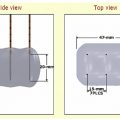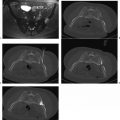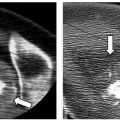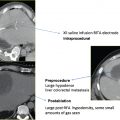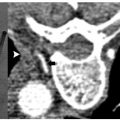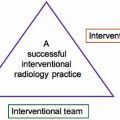10 Evidence-Based Practice
Even though tumor ablation, in one form or another, has been in clinical practice for more than 20 years, the lack of prospective randomized studies has been a source of frustration for interventional radiologists. Many factors have contributed to this problem, including the lack of funding (tumor ablation is far less profitable than systemic chemotherapy), the perceived threat to other specialties (resulting in limited referrals), and the generalized unawareness among the primary care or even oncologic community about tumor ablation.
During the last few years, however, many of these obstacles have been overcome. For example, the accumulation of results from many smaller studies has countered to a significant degree the effect of the lack of large prospective randomized studies. Even though the perceived threat to other specialties persists, more referrals are apparently being made, as an aging population represents a larger non-surgical pool. Additionally, the dissemination of information about these treatment options by word of mouth and more significantly via the Internet resulted in a significant increase in self-referrals. But what is most important from a scientific point of view is that all the published studies—even though each one is relatively small in number of subjects—have consistently demonstrated nearly identical results regarding the efficacy and safety of percutaneous tumor ablation.
Whether novice or seasoned, the practitioner must be acquainted with the current literature regarding the safety and efficacy of percutaneous tumor ablation as well as the relevant outcomes of other competing treatment options, such as external radiation, systemic chemotherapy, and resection. The four tables included in this chapter summarize the safety and efficacy data on percutaneous tumor ablation as of the time of writing; however, practitioners must always update their knowledge.
♦ Organ-Based Guidelines
Guidelines for Lung Cancer
Pending the results of the American College of Surgeons Oncology Group (ACOSOG) prospective randomized multi-center trial comparing surgical resection to percutaneous radiofrequency ablation (RFA), pulmonary ablation for primary lung cancer should be offered to patients who are not candidates for surgical resection. Primary lesion size of ≤3 cm is strongly correlated with a complete response. Lesions of >3 to 5 cm can also be targeted with RFA; however, long-term disease control is not as good, with reported complete response rates of between 30 and 60%. Lesions larger than 5 cm rarely show a complete response after RFA, and the decision to treat should be based on the specific clinical scenario ( Table 10.1 ).1–4 Noncurative ablation may be offered in certain other cases:
Symptom control: Pleura-based lesions can be targeted to mitigate related pain. Apical lesions that are growing rapidly can also be targeted, even before they become symptomatic, to prevent invasion of the brachial plexus (Pancoast’s tumor).
In cases in which tumor cytoreduction has been shown to improve survival (e.g., oligometastatic colon cancer, renal cancer): No data currently exist on the maximum number of lesions that is reasonable to target, as this depends mostly on the clinical scenario. For example, there is no indication to treat a single pulmonary lesion in a patient with an active brain metastasis. Similarly, one must question the benefit of treating a single pulmonary melanoma metastasis shortly after resection of the primary. On the other hand, there is a strong argument for treating a new pulmonary metastasis from colon cancer in a patient successfully treated with RFA for one metastasis 3 years earlier. These examples illustrate the fact that the decision to treat or not should be based not only on the tumor morphology but also on other relevant clinical factors, including the biology of the disease, patient comorbidities, and life expectancy.
Guidelines for Liver Cancer
Liver transplantation for hepatocellular carcinoma (HCC) yields the best chance for cure, with more than 70% survival at 5 years. However, fewer than 10% of patients are transplant candidates at presentation. Surgery and ablation are considered curative options; still those who are candidates for such procedures are in the minority. For lesions larger than 5 cm, surgical resection is superior both for primary liver cancer (HCC) as well as for metastatic disease, mainly colorectal carcinoma.5 Data for lesions smaller than 5 cm are contradictory, with many studies suggesting that ablation and surgical resection offer similar recurrence rates and survival. Such data are stronger for HCC ≤3 cm, which has helped popularize RFA both in the intraoperative and the image-guided settings.6–8 In deciding between resection and ablation, the physician must take into account the patient’s comorbid conditions and the prognosis related to the cirrhosis. Moderate to advanced cirrhosis argues for ablation, as surgical risks increase and expected survival benefit decreases. Table 10.2 summarizes the important studies related to liver cancer ablation.
Guidelines for Renal Cancer
Even though there are fewer studies on percutaneous ablation for renal cell carcinoma (RCC), they all show remarkable similarities with respect to efficacy and safety data. Almost universally, and irrespective of method of ablation (RFA or cryoablation), efficacy for RCCs ≤4 cm is nearly 100%, and the reported rate of significant complications is around 6%. Such patients are selected based on the size, location, and percutaneous accessibility of the RCC; nonetheless, the consistency of the data has propelled percutaneous ablation for RCC into clinical practice. Comparative data for RFA versus cryoablation are limited, with recent evidence suggesting that cryoablation is associated with a lower recurrence rate and fewer significant complications.9–11 As of now, and because long-term data on percutaneous ablation are lacking, the gold standard treatment for RCC remains nephron-sparing surgery. Patients who are not operative candidates, are predialysis, or have bilateral tumors or syndromes that place them at high risk for metachronous lesions are the ideal candidates for percutaneous ablations. Many patients who do not belong to any of the above categories still opt for percutaneous ablation due to the high efficacy rates12,13 and the fact that possible failure of ablation does not necessarily preclude surgical treatment ( Table 10.3 ).
Stay updated, free articles. Join our Telegram channel

Full access? Get Clinical Tree



